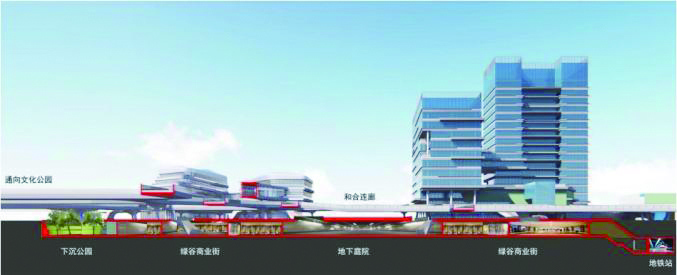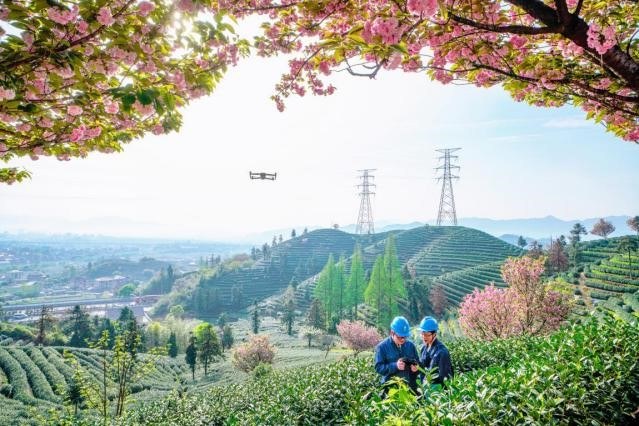
Xinhai Community in Jiaojiang district, Taizhou is currently under construction
Xinhai Community in Taizhou city’s Jiaojiang district is a type of future community that transforms and builds up old communities. The project is in intersection of the Xinhai Green Corridor Core Landscape Belt and the Central Avenue Urban Development Axis. A prime location in the city, it is known for convenient transportation and profound ecological and cultural heritage. The planned area for the project connects with Gaozhapu River and Kaifa Avenue in the north, Taizhou Avenue in the west, Central Avenue in the east and Hongjiachangpu River in the south, covering a total area of about 190 hectares. A total of 7,281 people will be rehoused after the upgrading of the community and 2,634 talented people will be introduced.
The construction of Xinhai Community is aimed at linking with surrounding areas, jointly developing into the engine of the Taizhou Bay Area and the core of the city. As a new type of future community, Xinhai Community will strive to become a model project of organic renewal in Taizhou’s urban area according to the concept and planning of Zhejiang province on future communities.
Xinhai Community stands in the central business zone of Taizhou city. As a pilot of community transformation and renewal, Xinhai Community has drawn on the idea of “neighborhood center” in Singapore. A diversified and open community with a population of 26,000 is planned to be established, which is mainly residential and integrates business, leisure, office, education, medical care, pension and community self-governance.
In terms of layout, along the Xinhai Green Corridor will lie a TOD complex, a neighborhood center, a cultural park, a residential cluster and an entrepreneurship and innovation center from north to south. At present, the designs for the TOD complex and the neighborhood center have already been submitted for approval, and the plan for the entrepreneurship and innovation center is being been prepared. Once finished, lifelong learning, healthy living for everyone, public innovation and entrepreneurship, circular development, artistic and traditional architectures, quality-life services and residents’ self-governance will all be part of the community, meeting people’s aspirations for a better life.
According to someone in charge of redeveloping the core area of the central business zone in Taizhou, the renovation and reformation of Zhujiadian, an urban village at the center of this area, began as early as in 2013. Six years later, in 2019, another project, the urban organic renewal of this area, was officially launched. Years of efforts have laid a solid foundation for the establishment of future communities such as Xinhai Community.
Indeed, with rapid urbanization, people are yearning for a high-quality life. However, with insufficient and low community governance capacity, poor use of space, inefficient and ineffective services, among a series of prominent community and urban issues, it is ever more imperative to seek high-quality development and transformation for urban communities.
What the construction of Xinhai Community attempts to address are precisely these problems. Built upon the old residential areas in Taizhou’s urban center, which were constructed between the 1970s to the 1990s, the completion of Xinhai Community will satisfy the four public demands of upgrading old and obsolete residential buildings, improving transportation, making life smarter and more intelligent, and providing more facilities for cultural and eldercare purposes. It will also help tackle four major practical problems, namely inefficient use of space in old residential areas, lagging public facilities and service, low ecological environment quality and weak neighbor relationships.
Hehe Culture, or Harmonious Culture, is integral to Taizhou’s distinctive culture, which is part and parcel of Xinhai Community. The implantation of Hehe Culture into the community will differentiate it other future communities. It will become a model Hehe community where the whole city converges, people live in harmony with nature and no boundaries or barriers exist.
“For example, we are creating a Hehe Corridor, which is a continuous and secure web of pedestrian lanes,” said the one in charge of redeveloping the core area of the central business zone, “With a width between three to five meters, residents can go about their daily life, including buying groceries and doing chores, through the web. The goal is to make all people living here enjoy the convenience of Xinhai Community’s public facilities, which is what makes us a model Hehe community.”
Editor: Huang Yan





